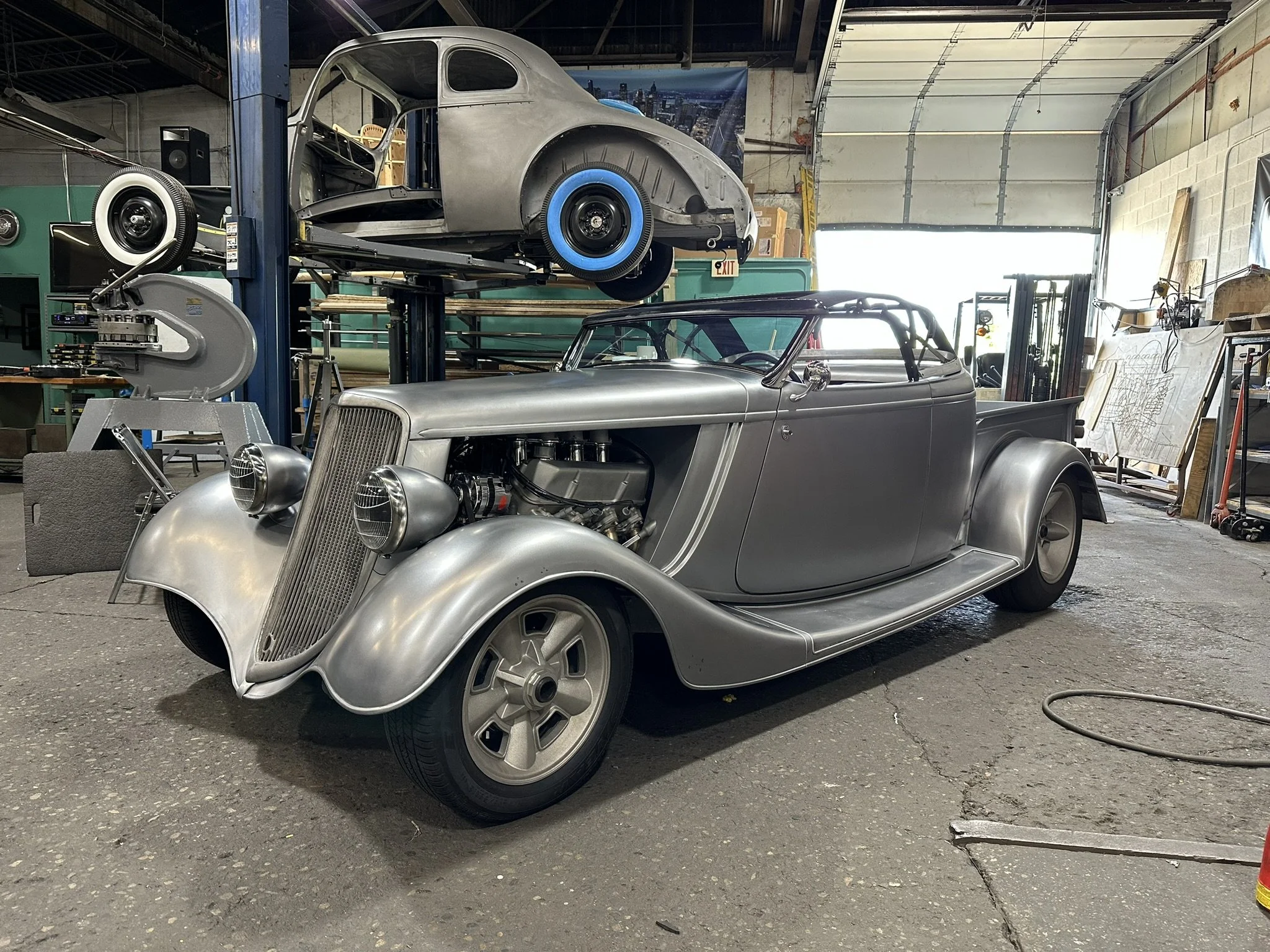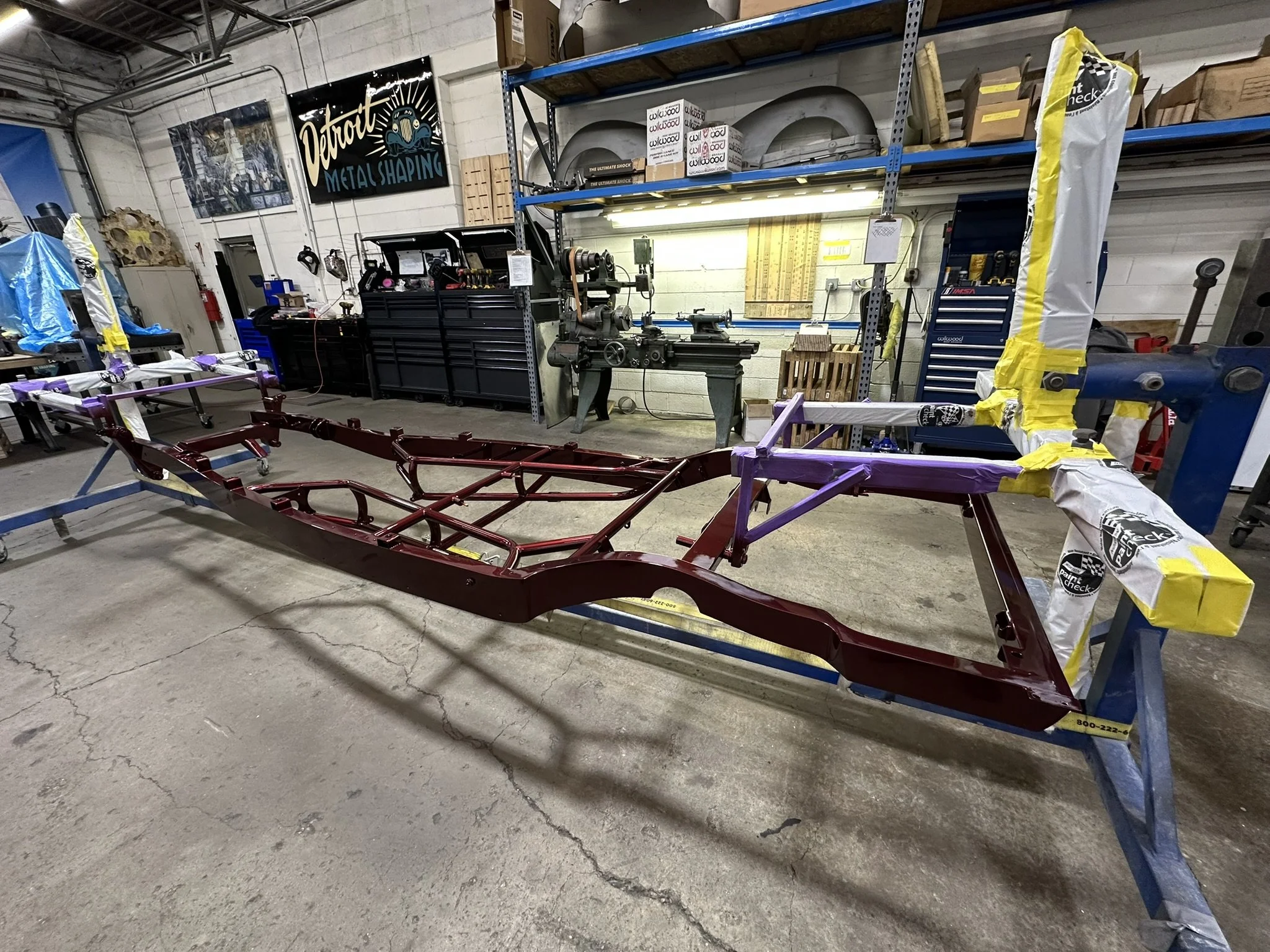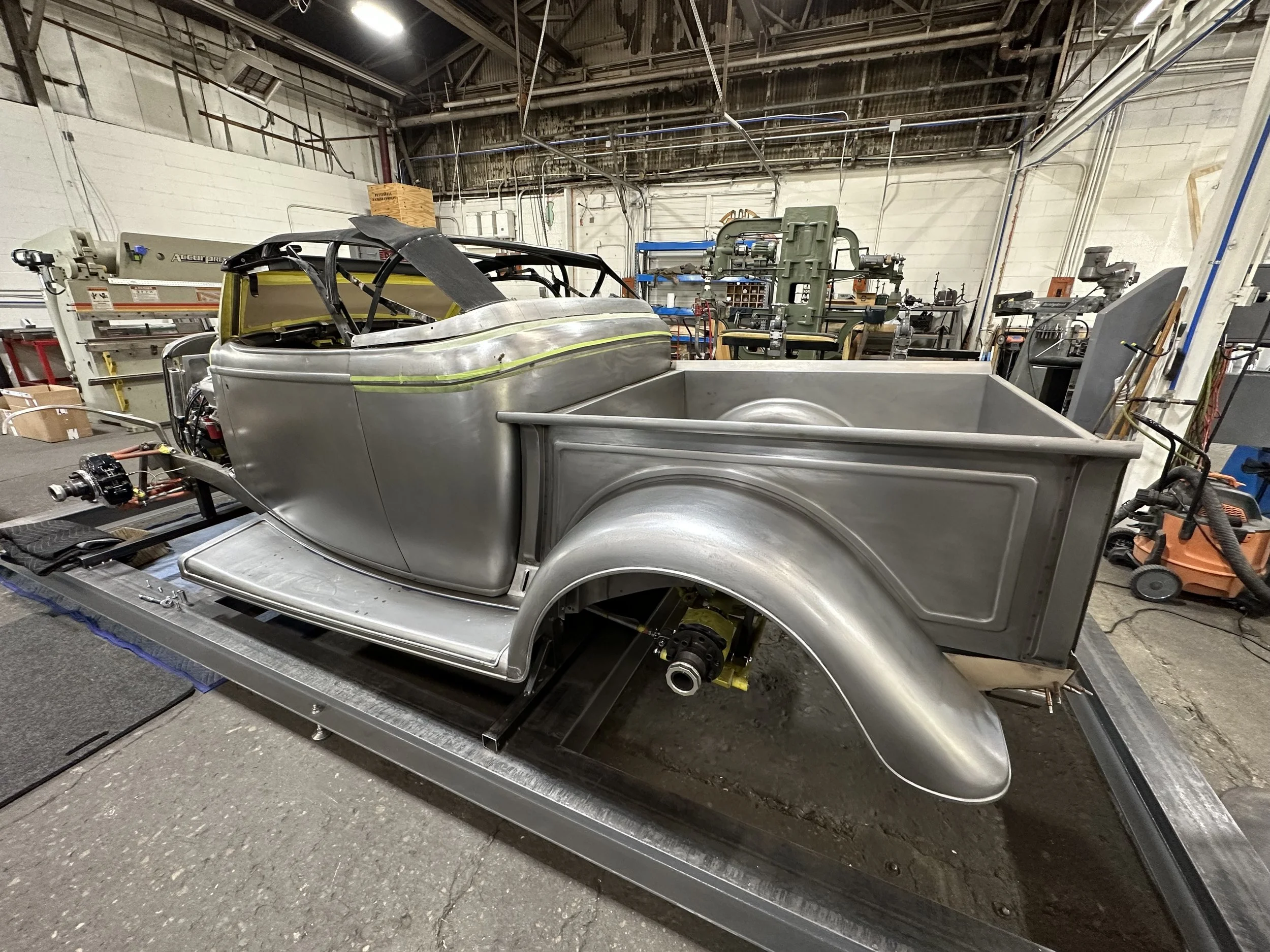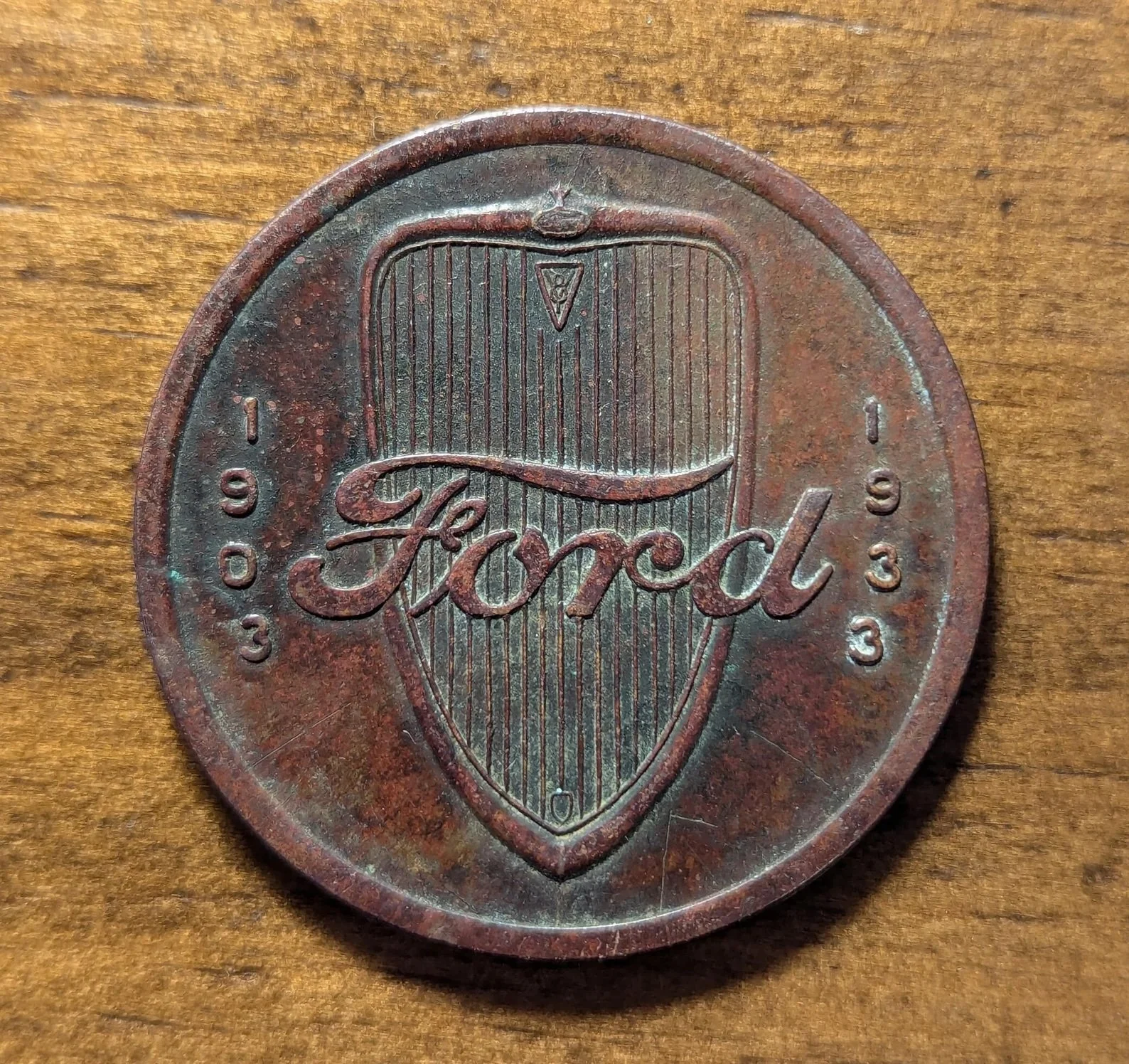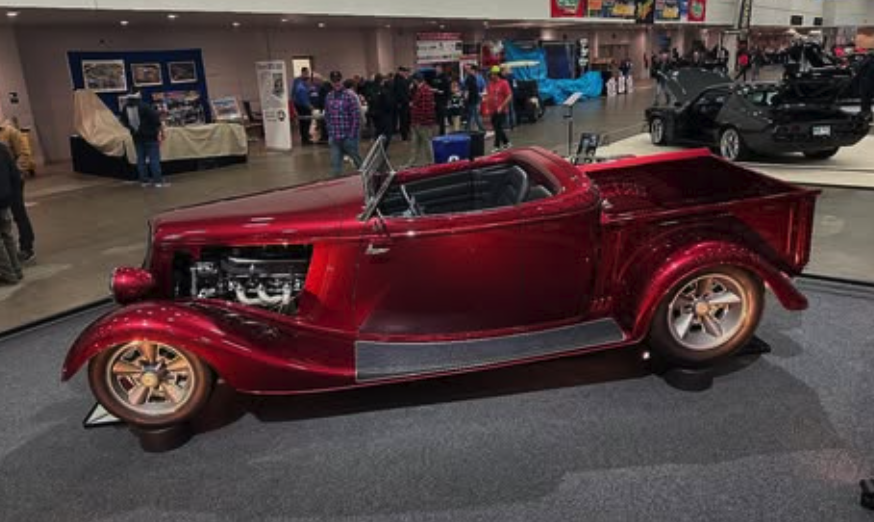1933 Ford Roadster Pickup: A One-of-a-Kind Custom Built Automotive
Some builds start with a rough sketch. Others begin with a deep respect for the past and a bold vision for the future. This one? It had both – a custom-built automotive creation that bridges history with innovation.
The concept was simple: create a never-before-built “sister” to the 1932 Ford Roadster Pickup, a 2015 build by the American Speed Company for Danny Shaffer, with Joe McKeen and Mark Trostle Sr. on board. But simple ideas don’t always translate into simple builds.
Logistics changed, time passed, and the project fizzled. But when Detroit Metal Shaping opened its doors, Joe saw the perfect opportunity to bring that 1933 custom-built car dream to life. He wanted a statement piece to kick off his new venture, and that 1933 Roadster Pickup kept calling to him.
So, he commissioned sketches and reconnected with Mark Trostle. Together, they put their visions on paper. The client was on board, and by Winter 2020, the project officially began.
The Vision: Bringing a Custom Classic Car to Life
This build wasn’t just about recreating a classic car; it was about imagining what a car from this era could look like with a modern twist. Since no 1933 Ford Roadster Pickup had ever existed, Joe and his team had to get creative.
The client’s preference for high-end, unique, classic cars meant the car had to be something special. Every detail needed to feel intentional – from the sleek body lines to the premium materials. But pushing the boundaries came with its own challenges, and that’s where things started getting interesting.
When it came to design, Joe worked closely with Mark Trostle to nail down the chassis length, proportions, and overall packaging. They knew this build had to balance the classic cars Ford 1933 look with modern touches. For Joe, the goal wasn’t just to make a beautiful car – it was to raise the bar in the world of custom-built automotive design. Every challenge they faced was an opportunity to refine the process and make it more efficient.
This car wasn’t just a tribute to the past – it was a statement about what the future of custom builds could look like.
The Design Process: CAD Automotive, Scanning & 3D Printed Car Parts
A bold design needs bold methods. Standard fabrication and pencil sketches wouldn’t cut it. For this build, Joe and his team turned to CAD, 3D scanning, and 3D printing to bring the vision to life. But it wasn’t without its bumps.
The design process began with a clear need for precision. With custom built cars like this, every detail had to be tailored perfectly. Enter CAD (Computer-Aided Design). It allowed Joe and the team to bring their sketches to life digitally, adjusting every measurement, angle, and detail before cutting a single piece of material. CAD gave them a solid foundation to ensure everything would fit seamlessly.
But CAD wasn’t the whole picture. They needed more detail and accuracy, so they turned to 3D scanning. By scanning components, they could create a virtual blueprint, ensuring parts were made to exact specifications. The scans provided clarity for elements that would’ve been impossible to visualize with just a sketch. This technology proved crucial for creating something so unique.
Then came 3D printing. For critical parts like the velocity stacks, 3D printing offered something traditional methods couldn’t: the ability to push design limits without sacrificing strength or precision. The result? Custom parts that were lighter, more detailed, and easier to reproduce—all while saving on costs. It was a perfect example of how modern tech could enhance traditional craftsmanship and break new ground in custom car builds.
But technology alone wasn’t enough. Joe and his team knew that custom car building is an art. And while CAD and 3D scanning helped them achieve precision, there’s a feel to the process that only traditional techniques can deliver. Whether hand-shaping metal or fitting body panels, expert craftsmanship was key to making sure the car felt authentic. The fusion of high-tech methods and time-honed skills is what gave the 1933 Ford Roadster Pickup its true character.
Unique Challenges & Standout Features
Building a custom one-off car is always a challenge. So many elements have to come together perfectly for everything to function and look right. For Joe, one of the biggest lessons has been the importance of the planning phase. It’s about managing not just the technical side but also the creative process—getting everyone on the same page and making sure the team has the freedom to do their best work. There’s a huge amount of trust in the people involved, from designers to craftsmen. Everyone has to have the space to bring their unique skills and aesthetics to the project while keeping it tied to the car’s overall vision.
The Body: Reworking the Speed 33
This build started with a Speed 33 reproduction body, but Joe and his team didn’t just drop it onto a frame and call it a day. The firewall was cut out, and everything behind the B-pillars was removed. The Speed 33 features a fully functional convertible top stack, which ultimately dictated the body length. From there, proportions were key—keeping the back wall of the cab as tight as possible while maintaining a clean, balanced look. The entire back half of the body and the tonneau cover were built from scratch to get the shape just right.
The Chassis: Stretched to Fit
With a reworked body, the chassis had to follow suit. Using math data from the Speed 33 body and top stack, Precision Hot Rods determined exactly how much stretch was needed—9 inches, bringing the wheelbase to 121 inches. Kugel IFS and IRS suspension, fully polished, were fitted to the build. Danny Tesar at Precision Hot Rods delivered a boxed chassis that’s as solid as it is clean, a foundation any custom builder would appreciate.
The Engine: A Roush Monster with Custom Jewelry
Roush Performance supplied the FE 511—a 600 HP, 600 ft/lb torque aluminum-block powerhouse with a Borla 8-stack injection system. But raw performance wasn’t enough. Joe and his team knew the engine bay had to be just as refined as the rest of the build. Custom valve covers, velocity stacks, and oil breathers were designed in-house to turn the engine into a showpiece. The result? Power and aesthetics in equal measure.
The Bed: Built from Scratch
What seems like a straightforward truck bed became one of the most painstaking parts of the build. Detroit Metal Shaping spent hours mocking up different configurations, testing gas tank placements, and fine-tuning every line to make sure it flowed seamlessly with the rest of the truck. Every single piece—the trim strips, wood inserts, and finishing details—was built in-house. The goal was clear: the bed had to look like it had always belonged, not like an afterthought.
Honoring Detroit With Top-Tier Automotive Design Legends
Detroit isn’t just the birthplace of the American automotive industry—it’s a city built on a legacy of custom craftsmanship. For decades, its innovators and builders have pushed the limits of design and engineering. This car, and the process behind it, is a continuation of that tradition.
One of the standout contributions to this build came from Root Brothers Designs. The twin brothers brought their expertise in both aesthetic design and CAD work, shaping key elements of the car. Their ability to blend intricate details with a clean, cohesive look helped define the character of the build. Mark Trostle, known for his timeless designs, played an equally critical role, shaping both the look and attitude of this car with his deep respect for craftsmanship.
Detroit’s custom car culture has always been about more than just building vehicles—it’s about pushing boundaries, experimenting with new ideas, and respecting the roots that built the industry. That’s why this build draws inspiration from some of the greatest OEM designers, including industry legends like Harry Bradley. A former GM designer, Bradley helped shape the look of countless classic cars, blending performance and aesthetics in a way that continues to influence today’s custom builders.
But honoring Detroit’s legacy isn’t just about design—it’s about collaboration. The backbone of Detroit’s custom car scene is its network of builders, fabricators, and experts, and the 1933 Ford Roadster Pickup is a direct result of that collective talent. The craftsmanship of Danny Tesar (Precision Hot Rods), Richard Sharer, Larry Erickson, Zach Gladfelter (Swiss Polishing), Jim Kemp (Roush Performance), Jon Wright (Custom Chrome Plating), Paddock’s Paint Works, Curtis Speed Equipment, Bowler Transmissions, Spineybeck Leather, Mike Lowengrubber, and Phillip Boyd all played a critical role in shaping this build.
For Joe and his team at Detroit Metal Shaping, this project wasn’t just about creating something new—it was about honoring the past, paying tribute to the city’s legendary builders, and ensuring the next generation carries that legacy forward. Every detail in this build stands as a nod to the vision and craftsmanship that have defined Detroit for decades.
The 1933 Ford Roadster Picked Up a Top Eight Titl
Looks and function. Modern and traditional. The way this 1933 Ford Roadster Pickup brought it all together didn’t just turn heads – it landed a Top Eight spot at the 2025 Detroit Autorama.
Autorama is no small stage. The Ridler Award is one of the big honors in custom car building, and making the Great Eight means this truck was built to a different standard. Every inch of it – from the stretched chassis to the hand-shaped sheet metal – was crafted with intention. No shortcuts, no compromises, just the right balance of tradition and new-school tech.
Check out Hot Rod Magazine’s full breakdown of all top eight contenders: The Great 8: Who Will Win the Ridler Award at the 2025 Detroit Autorama.
What’s Next for the 1933 Ford Roadster Pickup?
After all the hard work, the 1933 Ford Roadster Pickup is nearly ready to hit the road, but not before a little fine-tuning. The plan is to get it out there after the show season winds down and the weather warms up. This is when the real testing begins—taking it on the road, chasing down those little gremlins that always pop up with a fresh build, and making sure everything functions as it should. It’s all about getting the bugs out and fine-tuning every detail to perfection.
The next few months will be packed with shows. The Roadster Pickup will hit some major spots like the Good Guys Columbus Show, one of the top events in the car world, and the Triple Crown Hot Rod Show in Tennessee. These events will give the car a chance to shine, show off the hard work that went into it, and let people get a closer look at this one-of-a-kind custom build. It’s a prime opportunity to showcase what makes it stand out among other car show classic cars.
After that, it might take a little breather before hitting a big milestone: the Grand National Roadster Show on January 26, 2026. That’ll be a major moment for both the car and its owner, who will finally take it home after all the hard work has paid off.
But the road doesn’t stop there. With so many events lined up—Power Tours, Hot Rod Tours, and more—this car will continue to be seen by car enthusiasts everywhere. It’s not just a showpiece; it’s a car meant to be driven, enjoyed, and celebrated for the craftsmanship that went into every detail. So, while the first chapter of this build’s story is wrapping up, there are still plenty of roads ahead for the 1933 Ford Roadster Pickup to conquer.




